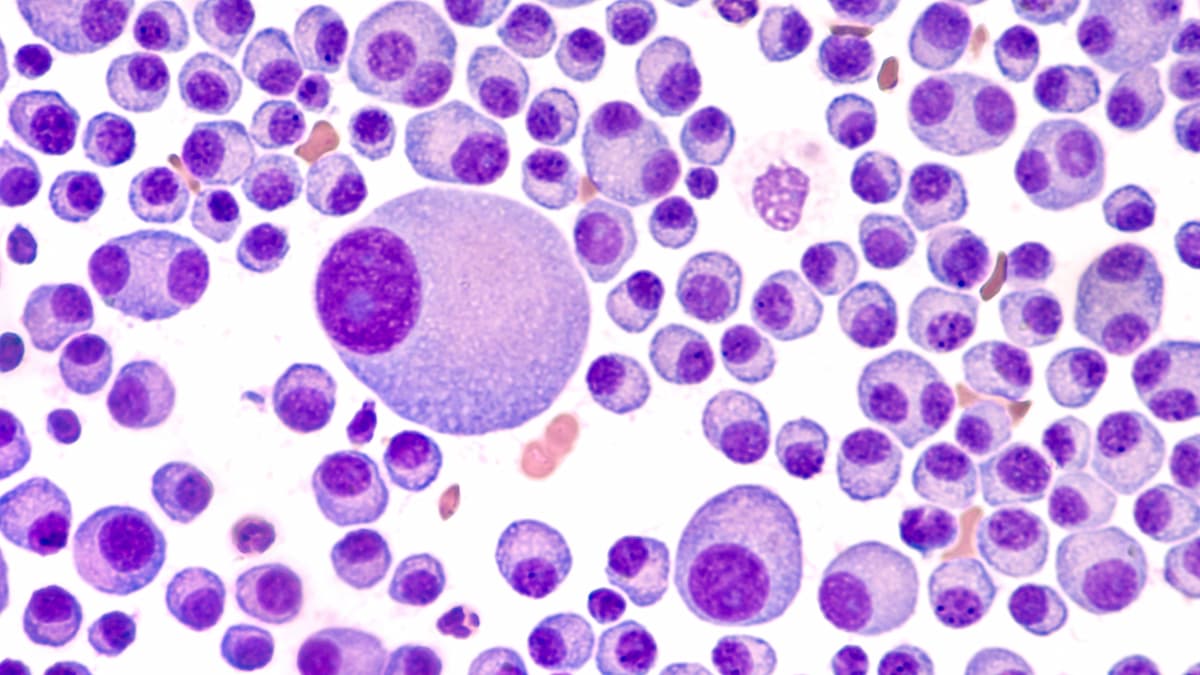Mezigdomide Combo Yields Promising Activity in R/R Multiple Myeloma
Investigators report that patients with relapsed/refractory myeloma treated with mezigdomide and dexamethasone primarily experienced myelotoxic effects.
Investigators of the multi-center, open-label phase 1/2 study evaluated mezigdomide in combination with dexamethasone in patients with relapsed/refractory multiple myeloma across 40 treatment sites.

Combining mezigdomide with dexamethasone produced promising preliminary efficacy in patients with relapsed/refractory multiple myeloma, according to findings from a phase 1/2 trial (NCT03374085) published in the New England Journal of Medicine.1
Among 77 patients enrolled in the study’s dose-escalation cohort, investigators reported an overall response rate (ORR) of 25% (95% CI, 16%-36%), which included complete responses (CRs) in 1%, very good partial responses (PRs) in 12%, and PRs in 12%. Based on preliminary efficacy, pharmacokinetics, and safety, investigators identified a recommended phase 2 dose (RP2D) of 1.0 mg of mezigdomide plus dexamethasone once a day in 21-day cycles.
Of those who were included in the dose-expansion cohort (n = 101), the mezigdomide-based regimen produced an ORR of 41% (95% CI, 31%-51%), which included stringent CRs in 2%, CRs in 3%, very good PRs in 20%, and PRs in 16%. The median duration of response (DOR) was 7.6 months (95% CI, 5.4-9.5), although investigators noted these data were immature. Additionally, the experimental treatment yielded a median progression-free survival (PFS) of 4.4 months (95% CI, 3.0-5.5).
The ORR was 30% (95% CI, 17%-46%) in patients with plasmacytomas and 50% (95% CI, 31%-69%) in those who received prior anti-BCMA therapy. Investigators also highlighted an ORR of 32% (95% CI, 18%-50%) in a subgroup of patients with high-risk cytogenetic abnormalities.
“Our findings show that mezigdomide in combination with dexamethasone has important clinical activity in this group of patients with very hard to treat myeloma,” lead study author Paul Richardson, MD, clinical program leader and director of clinical research at Jerome Lipper Multiple Myeloma Center at Dana-Farber Cancer Institute and an RJ Corman professor of medicine at Harvard Medical School, said in a press release on these findings.2 “This was particularly noteworthy because we were able to see responses in patients who had received prior BCMA-targeted therapy and in myeloma that had spread beyond the bone marrow and developed aggressive extramedullary disease, which is associated with an especially poor prognosis.”
Investigators of the multi-center, open-label phase 1/2 study evaluated mezigdomide in combination with dexamethasone in patients with relapsed/refractory multiple myeloma across 40 treatment sites. The primary end points in phase 1 were safety, pharmacokinetics, and RP2D. The primary end point in phase 2 was ORR, with DOR, PFS, and safety serving as secondary end points.
Patients 18 years and older with an ECOG performance status of 0 to 2 and adequate renal, bone marrow, and cardiac function were eligible to enroll on the dose-escalation portion of the study. Additionally, patients needed to have disease that was refractory to an immunomodulatory agent, a glucocorticoid, a proteasome inhibitor, and an anti-CD38 antibody to enroll on the dose-expansion portion of the study.
The median patient age was 65 years (range, 40-78) in the dose-escalation cohort and 67 years (range, 42-85) in the dose-expansion cohort. In the dose-escalation and dose-expansion cohorts, respectively, most patients were male (58% and 54%), White (90% and 76%), and had an ECOG performance status of 1 (64% and 56%). Additionally, most patients in each respective cohort had stage II disease (44% and 41%), and a high-risk cytogenetic profile (30% and 37%).
The most common any-grade adverse effects (AEs) among patients receiving mezigdomide plus dexamethasone in the dose-escalation cohort included neutropenia (81%), infections and infestations (74%), anemia (61%), and thrombocytopenia (51%). Grade 3 and 4 AEs, respectively, included neutropenia (23% and 48%), infection (36% and 4%), and anemia (38% and 0%). Investigators reported 3 deaths following AEs, 1 of which—an instance of brain abscess—was determined to be related to study treatment.
In the dose-expansion cohort, investigators reported several any-grade AEs including neutropenia (77%), infections and infestations (65%), anemia (52%) thrombocytopenia (43%), and fatigue (36%). The most frequently reported grade 3 and grade 4 AEs, respectively, were neutropenia (22% and 54%), infection (29% and 6%), and anemia (35% and 1%). Investigators attributed 2 of 5 deaths following AEs in this cohort to treatment with mezigdomide plus dexamethasone.
“We're hopeful that this body of data provides substantial evidence of the value of this approach to patients with an urgent unmet medical need, and further supports this oral agent being tested in combination with other back bone therapies, where our preliminary results are already promising, and now are being evaluated as part of larger, ongoing phase 3 clinical trials,” Richardson concluded.2
References
- Richardson PG, Trudel S, Popat R, et al. Mezigdomide plus dexamethasone in relapsed and refractory multiple myeloma. CC-92480-MM-001 Study Investigators. N Engl J Med. Published online August 30, 2023. doi:10.1056/NEJMoa2303194
- Potent oral agent that acts as both immunotherapy and targeted treatment produces high response rate in patients with hard-to-treat and refractory multiple myeloma when combined with steroid, trial sh. News release. Dana-Farber Cancer Institute. August 30, 2023. Accessed August 31, 2023. https://shorturl.at/hlJO6
Navigating AE Management for Cellular Therapy Across Hematologic Cancers
A panel of clinical pharmacists discussed strategies for mitigating toxicities across different multiple myeloma, lymphoma, and leukemia populations.